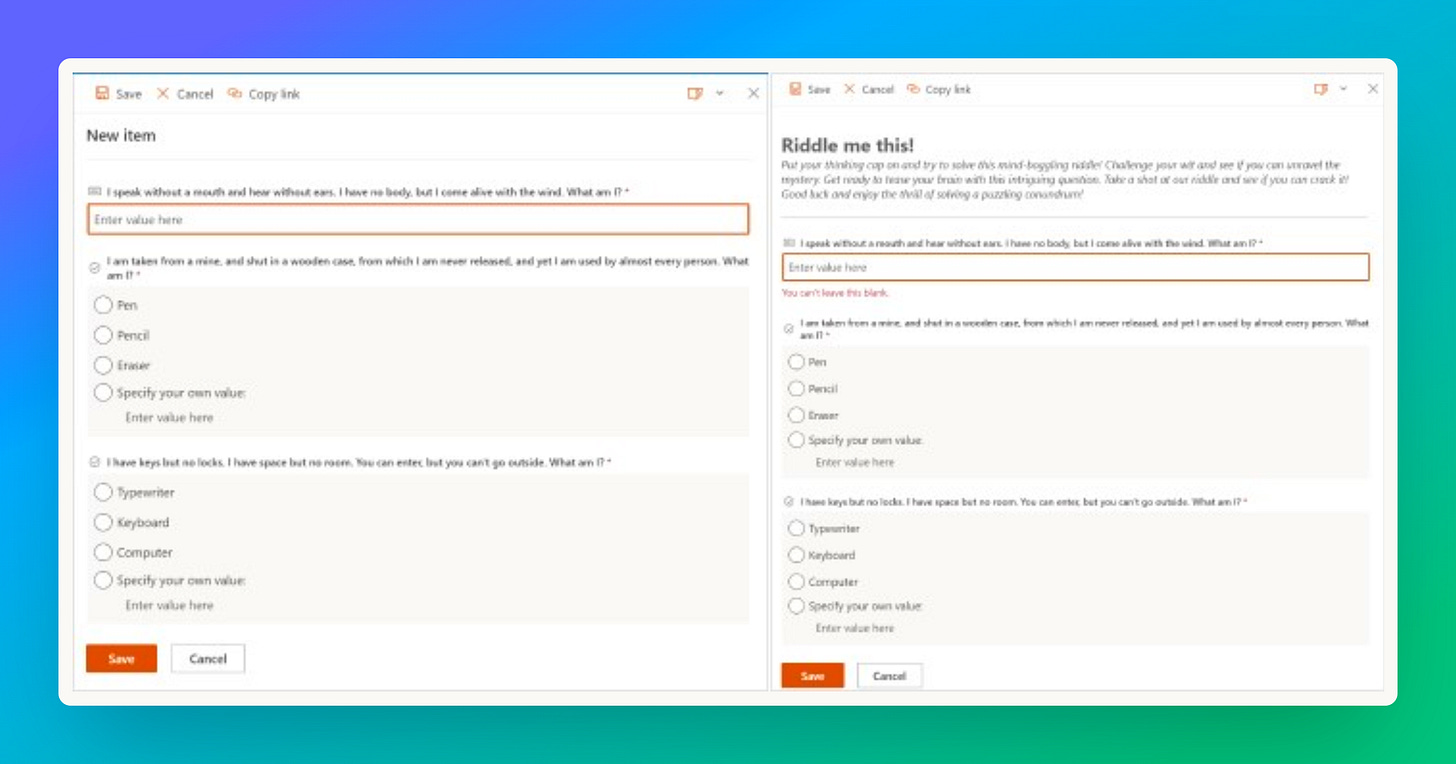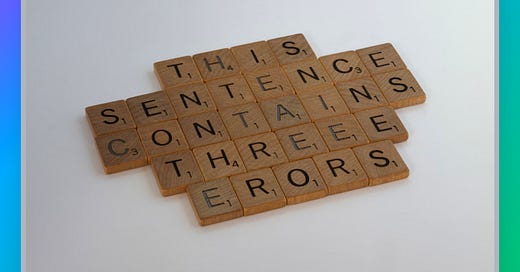In this article, a method for creating an interactive riddle game using Microsoft Forms, SharePoint, and Microsoft Lists is presented. By combining the capabilities of these tools, participants can enjoy an engaging and immersive experience.
The implementation process starts with Microsoft Forms, which provides a user-friendly interface and customizable features for designing riddles and creating a submission form. To enhance accessibility and user experience, SharePoint Online is utilized. The seamless integration of Microsoft Lists with SharePoint offers an alternative method for creating and managing lists.
Overall, this article showcases a approach to implementing a riddle game by harnessing the power of Microsoft Forms, SharePoint, and Microsoft Lists.
Why build a riddle game
When addressing the challenge of mitigating negative aspects that employees may encounter both at home and in the office, several factors come into play. One of these factors is the potential impact of tedium and boredom on remote workers, leading to decreased productivity and motivation. In a home environment, individuals may feel isolated and miss the social interactions that naturally occur in an office setting. Additionally, the absence of clear boundaries between work and personal life can make it challenging for employees to maintain a healthy work-life balance. These challenges can be particularly pronounced when faced with monotonous tasks or when employees feel disconnected from their team members and the organizational culture.
To overcome these challenges, organizations need to implement effective strategies that promote a positive workplace experience, regardless of the location where employees are working. Providing engaging and varied tasks, fostering regular communication and collaboration, and encouraging virtual social interactions are key approaches to combat tedium and maintain a sense of connection within remote teams. Technologies like SharePoint Online and Microsoft 365 can be leveraged to facilitate seamless communication, document sharing, and project management, ensuring that employees can collaborate effectively and stay motivated regardless of their physical location.
By recognizing and addressing the potential downsides of remote work, organizations can create a supportive and productive environment for their employees, enabling them to thrive both personally and professionally, whether they are working from home or in a traditional office setting.
One solution to promote a positive workplace experience is the implementation of games or activities that foster a sense of belonging and teamwork among employees, while also encouraging healthy competition and recognition based on merit. Incorporating gamification elements into the workplace can be an effective strategy to enhance employee engagement, motivation, and overall workplace experience.
By introducing interactive and collaborative games, organizations can provide opportunities for employees to bond, collaborate, and establish stronger connections with their colleagues. These games can include team-building exercises, virtual challenges, or online tournaments that encourage employees to work together towards a common goal. The competitive aspect adds excitement to the activities, motivating individuals to showcase their skills, strive for excellence, and push their boundaries.
In addition to fostering camaraderie and teamwork, implementing a merit-based reward system further incentivizes employees to actively participate and excel in these games. By recognizing and rewarding individuals based on their performance, organizations not only boost motivation and healthy competition but also reinforce a culture of meritocracy and fairness within the workplace.
By embracing gamification as a solution, organizations can foster a sense of belonging and teamwork among employees, creating an engaging and enjoyable work environment that ultimately boosts productivity and employee satisfaction.
The example: Riddle Me This!
One engaging way to leverage the capabilities of the Microsoft 365 platform is by implementing a riddle contest utilizing its various services and tools. This contest aims to challenge participants with three riddles, each designed to stimulate their problem-solving skills and creativity.
The first riddle presents an open-ended question, requiring participants to come up with their own solution or answer. This encourages critical thinking and allows individuals to express their unique perspectives. The subsequent two riddles offer multiple-choice options, providing participants with a set of potential answers to choose from. These multiple-choice options can be creatively crafted to increase the level of difficulty and keep participants engaged. However, the twist lies in the final option of each multiple-choice question, which remains open-ended, allowing participants to come up with an alternative answer if they believe none of the provided options are correct. This allows for flexibility and adds an element of unpredictability to the game.
By implementing a riddle contest on the Microsoft 365 platform, organizations can engage their employees or participants in a fun and intellectually stimulating activity. This not only promotes team-building and friendly competition but also encourages individuals to explore and utilize the various services and tools offered by Microsoft 365, enhancing their familiarity and proficiency with the platform. Ultimately, such initiatives contribute to a positive workplace experience, fostering creativity, problem-solving abilities, and a sense of community among participants.
Using Microsoft Forms for building the game
By implementing a questionnaire using Microsoft Forms, we can construct a form that incorporates the three riddles based on the aforementioned configuration.
Microsoft Forms provides a wide range of customization options that enhance the form's visual appeal and overall user experience. Through templates, images, colors, and even the option to include music, Microsoft Forms empowers us to create an engaging and enjoyable form.
Moreover, Microsoft Forms offers various features, including:
Sharing the form selectively with specific individuals within our organization, granting access solely to chosen members, or even enabling anonymous access for any user.
Establishing specific dates for opening and closing the response window, ensuring that participants can only submit their answers within a defined timeframe.
Allowing participants to modify their responses even after submission, granting them the flexibility to make changes or corrections as needed.
Sharing access to the form through different methods, such as a direct link, a QR code, or embedding it in various web applications or webpages. This facilitates convenient distribution through platforms like Outlook emails or messages in Microsoft Teams.
By utilizing these features of Microsoft Forms, organizations can create an interactive and flexible form for the riddle contest. Participants can easily access the form, provide their answers, and even make adjustments if necessary. The ability to customize the form's appearance adds an aesthetically pleasing touch, enhancing the overall experience for participants.
Overall, leveraging the capabilities of Microsoft Forms enables a seamless and user-friendly process for both administrators and participants involved in the riddle contest. The diverse options available facilitate efficient sharing, timely participation, and an enjoyable experience for everyone involved.
Using SharePoint Online for building the game
By establishing a SharePoint Online list, we can make use of SharePoint as the platform for entry and incorporate additional elements to enhance access to the form. For example, the creation of supplementary web pages containing explanations about the contest's mechanics, rules, prizes, a historical archive of previous contests, and a list of winners adds value to the user experience.
In this scenario, the SharePoint list will include the necessary fields, including two extra fields in addition to the 'Title' field, which can be customized to display the desired text. With these fields and additional configurations to restrict user access to other colleagues' responses, we will have a prepared list to serve as the foundation for collecting answers.
Another essential aspect to consider is configuring access to the list. We need to set permissions to include the employees who are intended to participate. We have the option to specify individual employees with precision or use broader options such as 'Everyone' or 'Everyone except external users.' By utilizing security settings, we can simulate the functionality of opening and closing the contest by adding participants on the opening date and removing them on the closing date.

The visual presentation of forms in SharePoint Online may not possess the most visually striking or aesthetically pleasing design. However, we can leverage the formatting capabilities available to us and introduce some details to enhance its visual appeal. Here are two potential solutions:
The first solution involves modifying the form's header and adding a title and description that provide guidance to employees regarding the contest.
The second solution entails utilizing Power Apps for customization. With Power Apps, we can create a more contemporary look. In my case, I have implemented a home screen similar to that of Microsoft Forms, allowing participants to gain an understanding of the contest before diving into the questions.
Lastly, if we prefer employees not to directly access the list, we can share the link to the data entry form and distribute it via email using Outlook, messages in Teams, or embed it in various platforms.
When sharing the link of a SharePoint Online form, you have the ability to modify the
Sourceparameter with the desired URL. By doing so, when users submit the form, they will be redirected to the specified URL. This feature allows for seamless navigation and enhances the user experience by directing them to relevant content or a designated landing page. For more detailed information and additional tricks regarding query string URLs in SharePoint and Microsoft 365, you can refer to the resource titled "Query String URL Tricks for SharePoint and Microsoft 365" available at this link.
Using Microsoft Lists for building the game
The last option I wanted to discuss is using Microsoft Lists. In my case, since I have already created the list in SharePoint Online, it automatically appears when accessing the Microsoft Lists application. This means that the process for creating and customizing a list using Microsoft Lists is the same. There are no additional considerations to take into account because it's the same underlying functionality. The only difference, if any, is that when creating a list using Microsoft Lists, we don't have to worry about the location of the list. We simply create it, and it's ready to use.
By utilizing Microsoft Lists, we benefit from the seamless integration with SharePoint Online. The list we created within SharePoint Online is readily available within the Microsoft Lists application, eliminating the need for additional setup or configuration. This streamlined approach allows us to leverage the familiar interface and functionalities provided by Microsoft Lists to further enhance and manage our contest effectively.
Whether we choose to create and customize the list directly within SharePoint Online or through Microsoft Lists, the process remains consistent. We can define the fields, configure permissions, and apply any desired formatting or customization. The ability to create a list effortlessly within Microsoft Lists offers a convenient alternative, particularly when the exact location of the list is not a critical consideration.
In conclusion, both options, creating the list directly within SharePoint Online or using Microsoft Lists, provide a seamless experience for managing our contest. The choice between the two depends on personal preference and the specific requirements of the implementation. Regardless of the approach, we can confidently proceed with creating and configuring the list to support our riddle contest effectively.
To wrap up
By harnessing the capabilities of Microsoft Forms, SharePoint Online, and Microsoft Lists, we can develop a comprehensive and effective solution for implementing a riddle game. Participants can interact with the riddles using the user-friendly interface of Microsoft Forms, while the additional features and customization options provided by SharePoint enhance the overall user experience. Furthermore, Microsoft Lists seamlessly handles the management of lists, ensuring a smooth and streamlined process.
References
Configure the list form: https://learn.microsoft.com/en-us/sharepoint/dev/declarative-customization/list-form-configuration
Query String URL Tricks for SharePoint and Microsoft 365: https://learn.microsoft.com/en-us/microsoft-365/community/query-string-url-tricks-sharepoint-m365
Thanks Mel Poole for the puzzle pieces background in the Power App customization: https://unsplash.com/es/@melpoole
Thanks Bret Jordan for the riddle picture in the intro of the article: https://unsplash.com/es/@brett_jordan
Thansk to Hector Sosa, the author of usescreenshot.app application, for allowing framing pictures: https://usescreenshot.app/
Don't forget to share the article with your friends and colleagues if you find it interesting, click on the heart if you like it, or click on the comments to share what you think of the article, if you would add more or if you want to clarify any of them.





